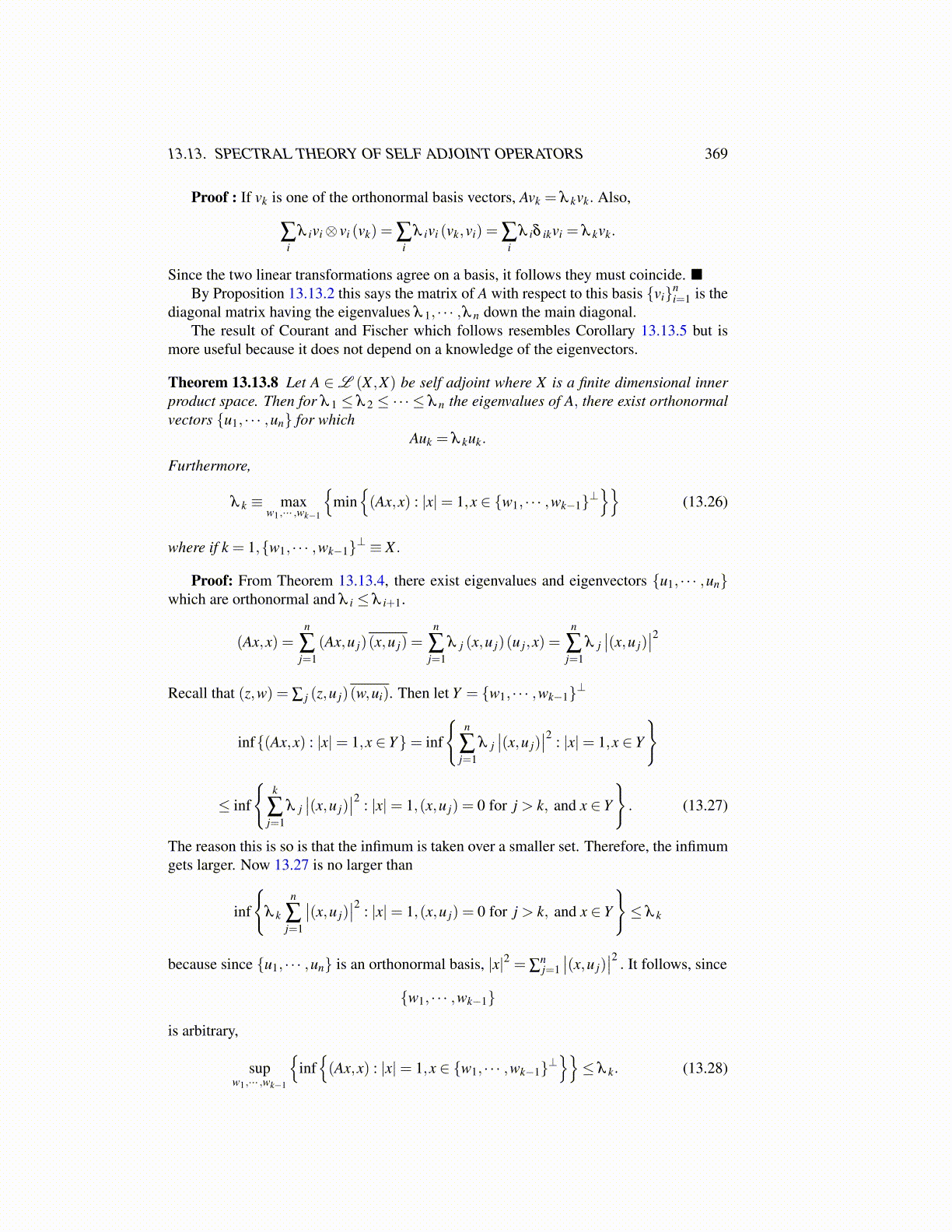
13.13. SPECTRAL THEORY OF SELF ADJOINT OPERATORS 369
Proof : If vk is one of the orthonormal basis vectors, Avk = λ kvk. Also,
∑i
λ ivi⊗ vi (vk) = ∑i
λ ivi (vk,vi) = ∑i
λ iδ ikvi = λ kvk.
Since the two linear transformations agree on a basis, it follows they must coincide. ■By Proposition 13.13.2 this says the matrix of A with respect to this basis {vi}n
i=1 is thediagonal matrix having the eigenvalues λ 1, · · · ,λ n down the main diagonal.
The result of Courant and Fischer which follows resembles Corollary 13.13.5 but ismore useful because it does not depend on a knowledge of the eigenvectors.
Theorem 13.13.8 Let A ∈L (X ,X) be self adjoint where X is a finite dimensional innerproduct space. Then for λ 1 ≤ λ 2 ≤ ·· · ≤ λ n the eigenvalues of A, there exist orthonormalvectors {u1, · · · ,un} for which
Auk = λ kuk.
Furthermore,
λ k ≡ maxw1,··· ,wk−1
{min
{(Ax,x) : |x|= 1,x ∈ {w1, · · · ,wk−1}⊥
}}(13.26)
where if k = 1,{w1, · · · ,wk−1}⊥ ≡ X .
Proof: From Theorem 13.13.4, there exist eigenvalues and eigenvectors {u1, · · · ,un}which are orthonormal and λ i ≤ λ i+1.
(Ax,x) =n
∑j=1
(Ax,u j)(x,u j) =n
∑j=1
λ j (x,u j)(u j,x) =n
∑j=1
λ j∣∣(x,u j)
∣∣2Recall that (z,w) = ∑ j (z,u j)(w,ui). Then let Y = {w1, · · · ,wk−1}⊥
inf{(Ax,x) : |x|= 1,x ∈ Y}= inf
{n
∑j=1
λ j∣∣(x,u j)
∣∣2 : |x|= 1,x ∈ Y
}
≤ inf
{k
∑j=1
λ j∣∣(x,u j)
∣∣2 : |x|= 1,(x,u j) = 0 for j > k, and x ∈ Y
}. (13.27)
The reason this is so is that the infimum is taken over a smaller set. Therefore, the infimumgets larger. Now 13.27 is no larger than
inf
{λ k
n
∑j=1
∣∣(x,u j)∣∣2 : |x|= 1,(x,u j) = 0 for j > k, and x ∈ Y
}≤ λ k
because since {u1, · · · ,un} is an orthonormal basis, |x|2 = ∑nj=1
∣∣(x,u j)∣∣2 . It follows, since
{w1, · · · ,wk−1}
is arbitrary,
supw1,··· ,wk−1
{inf{(Ax,x) : |x|= 1,x ∈ {w1, · · · ,wk−1}⊥
}}≤ λ k. (13.28)